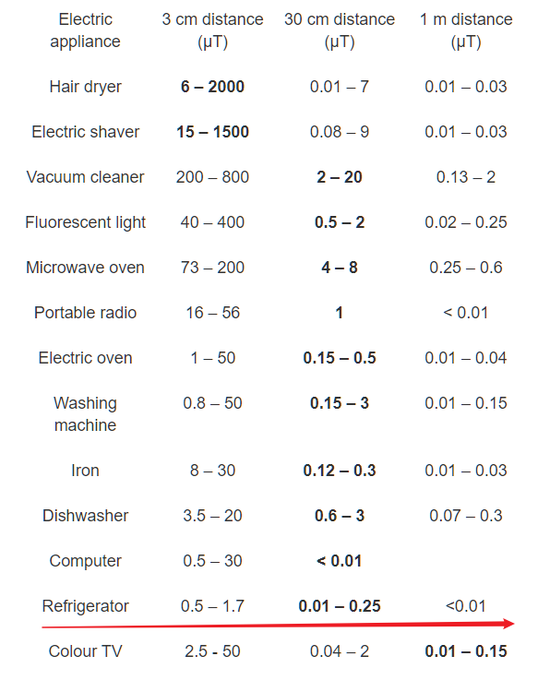Do you really know how to use the fridge? Answer these questions to know the truth
Is there radiation in the refrigerator?
Yes, but it is not harmful.
Basically, household electrical appliances can generate magnetic and magnetic fields that will spread to the surrounding environment in the form of electromagnetic waves, or radiation.
However, according to intensity, radiation can be divided into two categories. One is ionizing radiation, its energy is enormous and can disrupt chemical bonds, causing damage to the human body. The second radiation is non-ionized. The radiant energy generated by household appliances is very low and belongs to non-ionizing radiation.
Of course, low energy is also energy. So does long-term exposure affect the body? In this regard, scientists around the world have conducted tens of thousands of studies and so far no evidence of health effects of non-ionizing radiation has been found.

The radiation intensity of the refrigerator (the red brick part). Source: WHO
However, to be cautious, there are requirements on the strength of the magnetic field of household appliances, which cannot be stronger than 100 µT. According to estimates by the World Health Organization, the magnetic field intensity at a distance of 3 cm from a refrigerator is about 0.5 µT to 1.7 µT, much less than the limit. So you have nothing to worry about.
Will refrigerators affect the taste of food?
Yes, but it also has its own pros and cons.
Because flavor is a very subjective concept. So, use starch as an example to talk about the effect of low temperatures on its taste.

There are two types of starches in rice and wheat. One is called amylose, which is tightly textured like a string. The other is called amylopectin, which has many branches, but the structure is not too tight. During the cooking process, the structure of both types will gradually separate and become loose. Then, when the temperature drops, they will return to their original state. However, the amylopectin alone after synthesis will have a more compact structure, forming a resistant starch.
This resistant starch has a slight effect on taste. But it has a very low postprandial glycemic index. That is, eating lots of resistant starch increases blood sugar more slowly than the original starch.
This metabolism is affected by three factors. One is the amylose content. Glutinous rice and potato starch have less amylose than ordinary rice. The second is the temperature. Studies have shown that the fastest metabolism is around 4 ° C. Therefore, putting rice in a refrigerator can accelerate this process. The last element is fat. In short, the fact that foods change their flavor due to the effects of low temperatures is sometimes not a bad thing.
Will eating too much overnight food in the refrigerator cause cancer?
Is not.
Some people worry that nitrite levels in leftovers will continue to rise, adversely affecting the body.

However, experimental results show that nitrite concentration will actually increase when leftovers are left at room temperature for 48 hours. But it also does not exceed safety limits. And if placed in the refrigerator, nitrite growth rate will be slower.
Watermelon in the refrigerator to eat will cause diarrhea?
It's not a fridge's problem, it's a bacterial problem.
Because according to the characteristics of preferred temperature, bacteria can be divided into three types: low temperature, high temperature and average temperature. The majority of pathogenic bacteria are mesophilic bacteria, which multiply fastest at about 37 degrees Celsius. The temperature of the refrigerator is mainly 4 degrees Celsius, the lower the temperature of the freezer, so it has can greatly delay the growth of bacteria.
However, delay does not mean destruction. If bacteria already exist in food, it can still multiply and harm humans.

Pictures of some types of bacteria discovered in a user's refrigerator.
Principles of using the refrigerator properly
There are four main principles.
First of all, take the time to wash vegetables, fruits, fish and meat should also be cleaned before putting in the refrigerator. Pay special attention to washing your hands well as bacteria can pass from your hands into food before putting it in the refrigerator.
Second, raw and cooked foods should be handled separately to avoid cross contamination in the refrigerator.
Third, in the process of food processing, we must pay attention to temperature and time. For some foods, thorough cooking is required to kill pathogenic microorganisms.
Finally, processed foods should be refrigerated as soon as possible (1-2 hours) to avoid environmental contamination. Also, eat as soon as possible (preferably no more than 1 week), for both frozen meat.
Lastly, clean the refrigerator regularly to protect your appliance and your health.
 How to install the Wyze Cam
How to install the Wyze Cam How to troubleshoot common refrigerator problems
How to troubleshoot common refrigerator problems Anker Eufy Homevac H11 handheld vacuum cleaner, top choice for small room cleaning.
Anker Eufy Homevac H11 handheld vacuum cleaner, top choice for small room cleaning. 9 surprising Alexa tricks to try with your Amazon Echo tonight
9 surprising Alexa tricks to try with your Amazon Echo tonight Portable air conditioners: How to buy the best one for your home
Portable air conditioners: How to buy the best one for your home Google Home: 5 strange but delightfully useful places to put your smart speaker
Google Home: 5 strange but delightfully useful places to put your smart speaker